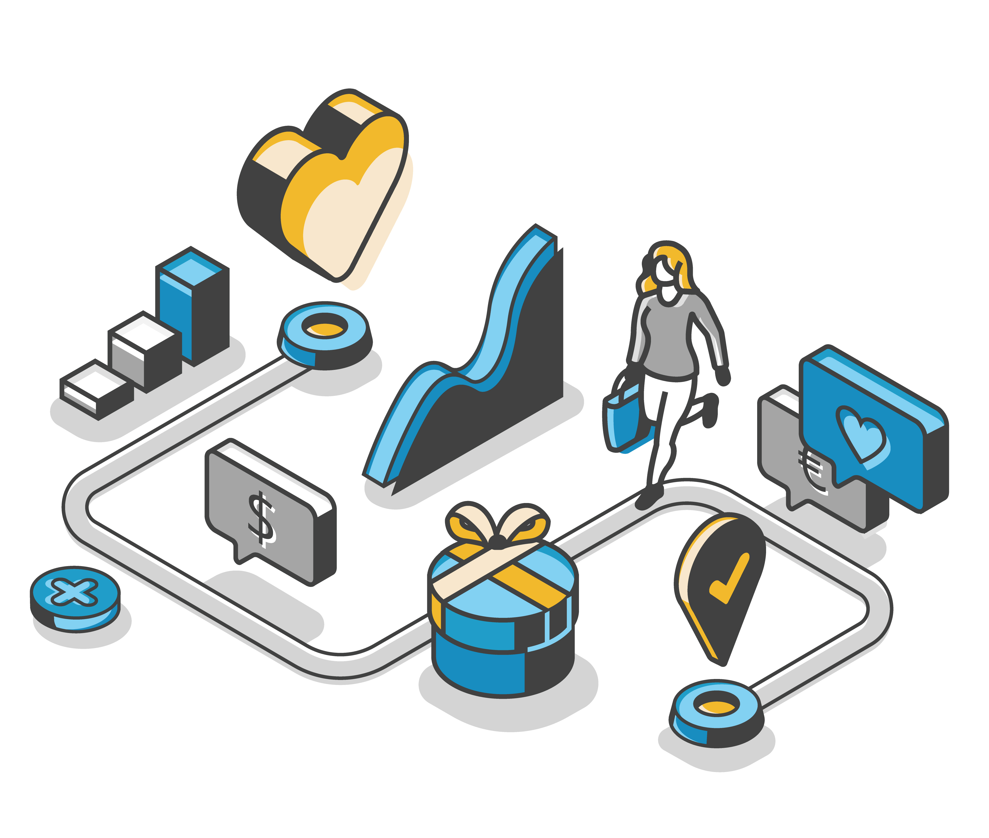What is the Customer Journey in Marketing?

If you want to succeed in your small business, you must know marketing. And if you’re going to succeed in marketing, you need to understand all of the terms that come with it. One such term is the customer journey. What is it? How can you ensure your customer has the most pleasant journey possible from discovery to purchase? This post will help you learn how to market better.
What is the Digital Marketing Customer Journey?
The customer journey is the process of how a person goes from hearing about your brand to being interested in and purchasing your product. The journey continues when the customer is interested in another product or service, or it faces turmoil when the customer is unsatisfied with your product.
Knowing how your business’s customer service journey works will help you attract, convert, and retain customers.
The Customer Journey Stages
The customer service journey is divided intо five stages. Let’s examine each stage and define its meaning.
Stage 1: Awareness
In this stage, the customer becomes aware of your product or service. They may have had an issue that your company can solve, and they came across your business when doing some research on what solution would work best for their needs. Or, they heard about your business through the grapevine. Regardless of how they heard about it, they’re now aware of your product.
Stage 2: Consideration
In this stage, the customer is contemplating buying your product or using your service. However, they have not made the plunge just yet. Reasons for this can include looking at the competition or reading your business’s reviews. If the potential customer believes that your business is the best solution for their needs, they will move on to the next stage.
Stage 3: Purchase
In this stage, the customer deposits money on your product or service. The transaction has now been completed, but the journey has not ended yet.
Stage 4: Retention
Obtaining a customer is essential, and retaining them is even more so. In this stage, the customer becomes more loyal to your product or service and wants to purchase future products. The business also needs to speak to the customer if there’s an issue with the product’s quality. Ensuring the customer is satisfied and that any problems are fixed will take the customer to this stage and on to the next one.
Stage 5: Advocacy
In this final stage, the customer enjoys your product so much that they’ll tell others. They may post about your product all the time on social media or recommend you if their followers have a similar issue that they once had. This is the ideal stage every business wants to reach. They want their customers not only to buy their products again and again but to promote the products as well.
What Are the Benefits of Understanding the Customer Journey
If you own a business or are planning to start one, it’s vital to know the stages of the customer journey.
It Helps You Learn More About Your Customer
When marketing, knowing the steps your customer will take is crucial. Every customer is different, and it’s vital not only to map out the customer demographics but also to put yourself in each customer’s shoes. Doing this can help you create personalized experiences that help each customer reach the end of their journey without any hangups.
Helping to Target Your Customer Better
Understanding the customer journey can help you figure out how to target your customers. Are they on certain social media platforms? Would they see an ad for your business on a city billboard? Knowing these things can help you gain more conversions.
More Conversions
Knowing the customer journey will lead to more conversions. You can tailor an experience that will make the customer want to buy from your business. For example, you may offer discounts to convert a customer on a tight budget, or you may offer different sizes for customers with unique measurements.
Better Retention
Understanding the customer journey marketing may help you retain customers. You’ll learn what makes a customer want to buy from you again. Do emails about the latest products help? Does making it right if a customer has an issue help your company? You can learn these things as you better understand your customer journey!
How to Create a Customer Journey Map: Customer Journey Example
No two journeys are alike, so it’s important to tailor your customer journey map to your unique business needs.
Start with the basics, such as the five stages and what you hope to achieve by using the map. In most cases, what you seek will be more customers and customer retention. But do you have a specific goal? Do you have any other goals you want your customers to achieve, such as subscribing to an email list? Knowing this can help you to create a better map.
If you already have customers, start creating personas for them. How old is your average customer? What do they do when they have free time? What do they see in a great product or service, and what turns them off using another?
If you have no clue, create a basic outline of your customer persona and update it as you go. Use feedback, analytics, and even visiting an average customer’s social media profile to get a better idea of who they are.
Finally, create an actual map. You can do this by drawing it on a marker board or sheet of paper, mapping it in graphic design software, or even using generative AI. Adjust and tweak this map as you make your own journey. For the path you take may have a detour or two.
What is the Importance of Analyzing the Customer Journey?
You should not only map out the customer journey but also pay attention to every step you make. Doing so can help you do the following:
Identify Bottlenecks
In business, a bottleneck is anything that restricts the flow of business. In the context of customer journeys, this could mean that the product is too expensive, you don’t explain the product enough, there aren’t enough payment options, or the competition offers a superior product. Once you identify these bottlenecks, it’s crucial to stop them in their tracks.
Learning Customer Behaviors
Paying attention to your customer’s journey can help you identify common behaviors and alert you to any potential changes in behaviors. Behaviors may start to change over time based on trends or your audience aging out of certain traits.
Better Marketing
Finally, analyzing customer behavior can help you market better. The more efficiently you market, the more conversions you get without breaking the bank on your advertising budget.
How Can You Optimize Your Customer Journey?
There are several tangible steps you can take as a business to optimize the journey your clients may take. These steps include:
Personalize the Content Offered to Your Customers
Through custom emails and recommendations based on previous purchases, no two customer experiences will be alike. The more your business seems to treat each customer as special, the more conversions you will have.
Make the Purchase Process Easy
Does your website load well? Is it easy to find the products and services? Do you have plenty of payment options? Can a customer buy a product without needing an account? Making the purchasing process as streamlined as possible can shorten the customer journey considerably.
Have a Valuable Customer Service Team and Policies
Your customer service team should respond quickly and help customers with any problem they have. You can also implement AI chatbots to answer common questions and troubleshoot issues. But never eliminate the human out of the equation, and ensure that it’s easy for a customer to speak to a human if they want to.
In addition, you need to have good policies should a customer not be satisfied. You may make returns easy or offer a coupon toward a future purchase. Making it right can turn a customer who promises to never shop at your business again into a customer for life.
Ask for Feedback
Finally, the best way to optimize a customer journey is to ask for feedback. After the product has been delivered, you may ask the customer to rate their experience. You may also make posts on social media asking what customers would like to see. Even if someone leaves you a scathing review, collect any valuable feedback. Then, respond. Eliminate the things that most customers seem to dislike and enhance and create the things the customers like or want.
Final Thoughts
Customer service journeys involve the process your customer goes through, from being aware of your product in passing to being its biggest advocate. The customer service journey is simple to understand, but mastering it is a whole other story. Every person will have their own journey that you need to guide to its destination. So research, reach out, and refine as you learn more about your customers. Good luck!

Guinn Latoria
Digital Marketing Manager